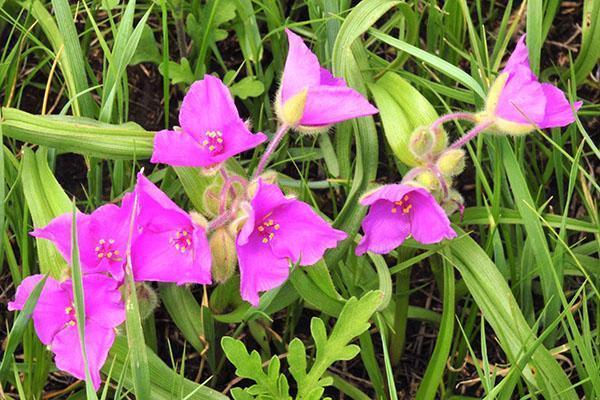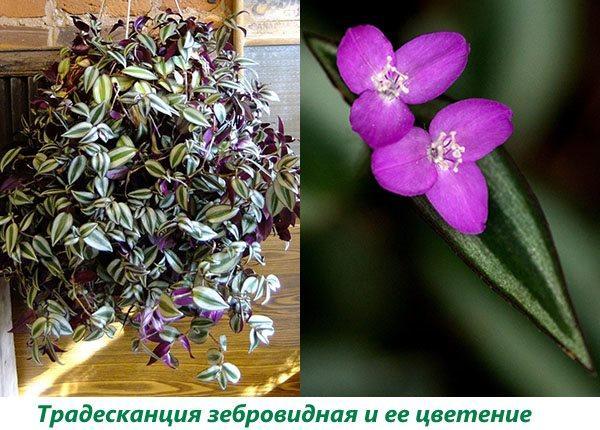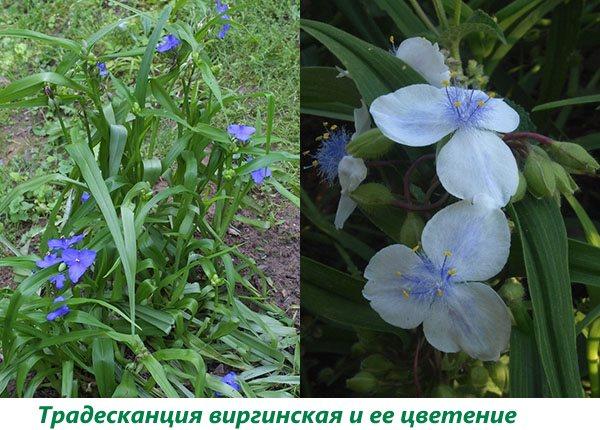We present to your attention the types and varieties of Tradescantia for growing at home
 Tradescantia belong to the original American species, found in the wild from the southern borders of Canada to Argentina itself. Numerous types and varieties of Tradescantia in the photo amaze with a variety of external appearance. The reason is not only in the vast habitat, stretching from regions with a temperate climate to the very tropics. The number of hybrids and varieties of Tradescantia is due to flower growers and breeders who have sincere love and scientific interest for the flower. the types of tradescantia presented in the article will decorate flower beds and alpine slides on the personal plot and window sills in the house.
Tradescantia belong to the original American species, found in the wild from the southern borders of Canada to Argentina itself. Numerous types and varieties of Tradescantia in the photo amaze with a variety of external appearance. The reason is not only in the vast habitat, stretching from regions with a temperate climate to the very tropics. The number of hybrids and varieties of Tradescantia is due to flower growers and breeders who have sincere love and scientific interest for the flower. the types of tradescantia presented in the article will decorate flower beds and alpine slides on the personal plot and window sills in the house.
Tradescantia zebrina

The zest in the appearance of the plant is made by leaf blades. On the back, they are painted in rich purple tones. And their outer side is colored with bright white and silver stripes on a green background. It is this feature that determined the name of this type of tradescantia.
Virginia Tradescantia (Tradescantia virginiana)
 This garden tradescantia owes its name to the place of its natural growth. In addition to Virginia, perennials are found in many parts of the eastern part of the country. Thanks to the abundant flowering lasting all summer and quite bright for the genus, the Virginia tradescantia was cultivated and fell into the circle of interests of breeders. On its basis, a great many varietal and hybrid plants have been obtained, combined into a separate species.
This garden tradescantia owes its name to the place of its natural growth. In addition to Virginia, perennials are found in many parts of the eastern part of the country. Thanks to the abundant flowering lasting all summer and quite bright for the genus, the Virginia tradescantia was cultivated and fell into the circle of interests of breeders. On its basis, a great many varietal and hybrid plants have been obtained, combined into a separate species.
The resulting garden varieties of this type of tradescantia, as in the photo, perfectly take root not only in the gardens of the USA and other countries of the American continent, but have long been recognized by European gardeners. They look great as separate compositions and in combination with beautiful roses, daylilies and other flowers.
It is very easy to recognize the plant by its straight, lodging stems only in exceptional cases and elongated pointed linear leaves. The height of graceful leafy shoots reaches 60 cm. During the summer season, the plant forms a dense curtain, which in the second half of summer is additionally decorated with a lot of flowers. Corolla of Virginia tradescantia, consisting of three broad-ovate petals, are collected in umbellate inflorescences at the tops of the stems and emerge from the axils of long 20-centimeter leaves.
The color range of flowers is very wide: from almost white to violet-pink or dark blue hue. In nature, pollination, ovary formation and seed ripening occur.
Tradescantia Anderson (Tradescantia x andersoniana)
 Hybrid plants obtained from crossing other species with Virginia Tradescantia are today called Anderson's Tradescantia. These are beautifully flowering garden decorations, recognized all over the world and actively used for landscaping gardens and parks, even in central Russia.
Hybrid plants obtained from crossing other species with Virginia Tradescantia are today called Anderson's Tradescantia. These are beautifully flowering garden decorations, recognized all over the world and actively used for landscaping gardens and parks, even in central Russia.
Modern varieties of Anderson's Tradescantia amaze with the splendor of colors. Plants can have not only green, but also purple, variegated and even almost yellow foliage.And the flattened corollas of flowers are painted in all shades of blue, pink, lilac.
 Among the varieties of this type of Tradescantia, as in the photo, there are plants with unusual semi-double flowers.
Among the varieties of this type of Tradescantia, as in the photo, there are plants with unusual semi-double flowers.
White-flowered Tradescantia (Tradescantia albiflora)
 In some types of Tradescantia, you can find not one, but several synonymous names. White-flowered tradescantia is no exception, which growers also know as tricolor tradescantia. In fact, the last name does not belong to the entire species, but only to the only variety in which pink stains and strokes are clearly visible on the striped, white-green foliage.
In some types of Tradescantia, you can find not one, but several synonymous names. White-flowered tradescantia is no exception, which growers also know as tricolor tradescantia. In fact, the last name does not belong to the entire species, but only to the only variety in which pink stains and strokes are clearly visible on the striped, white-green foliage.
The plant from the South American tropics stands out for its smooth, pointed, cordate foliage, creeping knotty shoots, and small white flowers that give the species its name.
 In addition to the tricolor variety and plants with smoothly colored leaves, there are varieties such as Albo vittata white-flowered tradescantia, in which the leaves are decorated with many green and white stripes.
In addition to the tricolor variety and plants with smoothly colored leaves, there are varieties such as Albo vittata white-flowered tradescantia, in which the leaves are decorated with many green and white stripes.
Riverine Tradescantia (Tradescantia fluminensis)
 An equally unpretentious and fast-growing species like White-flowered Tradescantia found its way into indoor pots from the Brazilian humid forests, where rhizome perennials form extensive thickets, displacing all other herbaceous plants.
An equally unpretentious and fast-growing species like White-flowered Tradescantia found its way into indoor pots from the Brazilian humid forests, where rhizome perennials form extensive thickets, displacing all other herbaceous plants.
 Riverine Tradescantia can be distinguished from the previous representative of the genus by brownish or red-purple adult shoots and the same color of the back of the leaves. In wild specimens, the leaves have an even bright green color.
Riverine Tradescantia can be distinguished from the previous representative of the genus by brownish or red-purple adult shoots and the same color of the back of the leaves. In wild specimens, the leaves have an even bright green color.
 But as you can see in the photo, varieties of the type of river Tradescantia, grown in culture, can decorate the house with striped and even spotted foliage. An example is Maiden's Blush with leaves in all shades of pink, white and green. Randomly scattered spots and strokes give the plants a unique look.
But as you can see in the photo, varieties of the type of river Tradescantia, grown in culture, can decorate the house with striped and even spotted foliage. An example is Maiden's Blush with leaves in all shades of pink, white and green. Randomly scattered spots and strokes give the plants a unique look.
 The flowers of the riverine Tradescantia in all varieties are small, white, located in the axils of the upper leaves. Small flowers of Tradescantia look amazingly tender in the composition next to the tree lemon or strict ficus.
The flowers of the riverine Tradescantia in all varieties are small, white, located in the axils of the upper leaves. Small flowers of Tradescantia look amazingly tender in the composition next to the tree lemon or strict ficus.
Tradescantia blossfeldiana
 In Argentina, another type of Tradescantia lives, today it has found a place for itself on home windowsills. This is Blossfeld's Tradescantia, recognizable by its dense, red-green stems and pointed, lanceolate leaves up to 8 cm long. The underside of the leaf is purple, the top is dark green with a reddish or purple tint. The leaf plates are rough; the pile is clearly visible at the nodes and at the base of the leaves.
In Argentina, another type of Tradescantia lives, today it has found a place for itself on home windowsills. This is Blossfeld's Tradescantia, recognizable by its dense, red-green stems and pointed, lanceolate leaves up to 8 cm long. The underside of the leaf is purple, the top is dark green with a reddish or purple tint. The leaf plates are rough; the pile is clearly visible at the nodes and at the base of the leaves.
 The axillary inflorescences are also pubescent, consisting of several purple or lilac-pink corollas. Blossfeld's Tradescantia petals, bright on top, are almost not colored below. The center of the rim is also noticeably bleached.
The axillary inflorescences are also pubescent, consisting of several purple or lilac-pink corollas. Blossfeld's Tradescantia petals, bright on top, are almost not colored below. The center of the rim is also noticeably bleached.
In varieties with variegated foliage, the brightness of the color depends on the lighting conditions. Falling in the shade, the leaves of Blossfeld's tradescantia can completely lose their ornament and turn, as in the photo, green.
Tradescantia sillamontana
 Unlike most species and varieties of Tradescantia that prefer to settle in a humid environment, the photo shows a plant that has perfectly settled in semi-empty conditions. The unusual habitat of Tradescantia sillamontana is indicated by a thick long pile, which covers the knotty stems and small ovoid leaves of the flower. Thanks to this natural protection, Tradescantia is not afraid of the loss of already accumulated moisture and grows well in its homeland on alpine hills and curbs. But in Europe and Russia, the plant is too cold in winter, so it is better to grow a spectacular view in winter indoors, bringing it to fresh air only in the warm season.
Unlike most species and varieties of Tradescantia that prefer to settle in a humid environment, the photo shows a plant that has perfectly settled in semi-empty conditions. The unusual habitat of Tradescantia sillamontana is indicated by a thick long pile, which covers the knotty stems and small ovoid leaves of the flower. Thanks to this natural protection, Tradescantia is not afraid of the loss of already accumulated moisture and grows well in its homeland on alpine hills and curbs. But in Europe and Russia, the plant is too cold in winter, so it is better to grow a spectacular view in winter indoors, bringing it to fresh air only in the warm season.
 The height of a perennial rhizomatous plant does not exceed 40 cm. Young stems initially remain upright, but with growth they sink to the ground. During flowering, single pinkish-lilac small flowers appear on the tops of the stems.
The height of a perennial rhizomatous plant does not exceed 40 cm. Young stems initially remain upright, but with growth they sink to the ground. During flowering, single pinkish-lilac small flowers appear on the tops of the stems.